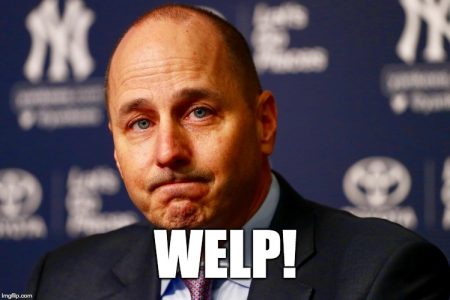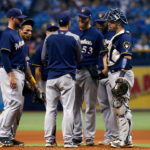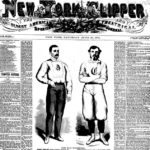The End of (Trading) Days!
 July 31 was the last chance for a Major League Baseball GM to balance the books and add a few critical pieces to recalibrate his team’s chances to make the postseason and, if they’re good enough, win the World Series. That’s because 31 July was the trade deadline day. Perhaps the most important day of the regular season.
July 31 was the last chance for a Major League Baseball GM to balance the books and add a few critical pieces to recalibrate his team’s chances to make the postseason and, if they’re good enough, win the World Series. That’s because 31 July was the trade deadline day. Perhaps the most important day of the regular season.
The Last Three World Series Winners
Last year, Boston acquired Nathan Eovaldi at the deadline, and he made quite a difference in the postseason.
The year before, the Houston Astros added Jason Verlander on a waiver deal at the last moment on August 31, and he was arguably the reason Houston won the World Series.
Going back to the Cubs World Series victory in 2016, they added Aroldis Chapman to their bullpen at the trade deadline, and he was instrumental in their first Series win in 108 years.
So, adding the right pieces can make a difference for a contenders.
How are the Prospects in hose Trades Doing?
The Cubs traded Gleyber Torres, Billy McKinney (since traded to Toronto in the J.A. Happ deal last year), Adam Warren (signed with San Diego as a free agent), and Rashad Crawford (still with the Yankees, shuttling between A and AA minor league teams) to the Yankees for Chapman. As is well known by now, Gleyber Torres has become a star for the Yankees.
The Astros sent right-hander Franklin Perez, outfielder Daz Cameron and catcher Jake Rogers, and cash to the Tigers for Verlander. Rogers will be the first of the three players to debut in the majors with Detroit later this week. While Boston sent left-hander Jalen Beeks to the Tampa Bay Rays to complete the Nathan Eovaldi trade. Beeks started against the Red Six in Tampa last week.
How good these players will become is still an open book. Only one, Gleyber Torres, has distinguished himself, so far.
GMs understand that, as Baseball America has reported, only 20.1% of prospects traded at the July 31 deadline since 2003 have ever played at least two years in the major leagues and achieved a positive career Wins Above Replacement statistic. That’s one prospect in five makes who makes a difference.
What Comes Around, Goes Around
GMs throughout baseball are forced to vote with their inventories, showing their preferences. Revealing which players being put up for auction were most coveted around the league. Which players other teams desperately want to purchase. And of course, which players had little or no value.
The truth is, despite the educated guesswork and numerical analyses of player skills and performance, no one really knows which prospects will pan out. Sometimes, experienced players will perform up to expectation. Which is why many teams want to acquire another organization’s top prospects. Less chance for error. Greater chance the prospect will develop into a contributor near-term. These days, trades for top prospects are tough to complete, given the financial value of a prospect and the reluctance of teams to part with them.
Even top prospects it seems did not convince San Francisco to part with Madison Bumgarner, now that they might be one of the two NL Wild Cards. A month ago it seemed Bumgarner would be moved for sure. But that’s baseball.
So, it’s a crapshoot once prospects are involved in a deal, even if they are top-rated. So, the Mets hope they know what to expect from the experienced Marcus Stroman. But the Blue Jays will not know about the two pitchers they acquired for some time to come.
A 2012 Trade between the Mets and Blue Jays
When the Mets (Sandy Alderson, GM) and Blue Jays (Alex Anthopoulos, GM) did business in 2012, Toronto acquired R.A. Dickey after his Cy Young Award-winning season in 2011. The Mets also sent catchers Josh Thole and Mike Nickeas to Toronto in the deal.
Toronto sent catcher Travis d’Arnaud, right-handed pitcher Noah Syndergaard, catcher John Buck and outfielder Wuilmer Becerra to the Mets.
The key pieces at the time of the trade were R.A. Dickey and Travis d’Arnaud. Though, as things have worked out, d’Arnaud was released by the Mets in April this year and has experienced a renaissance of sorts now that he’s a member of the Tampa Bay Rays. Syndergaard is still pitching for the Mets, despite speculation he was going to be traded yesterday.
As for the others, John Buck was a salary dump by Toronto to even out Dickey’s money. He performed capably for the Mets for one season before he moved on to the Los Angeles Angels. He is out of baseball today.
Only d’Arnaud and Syndergaard are still active in the game. And Syndergaard has turned out to be the most valuable piece of the deal seven years later.
A Day of Surprises
The trade deadline day was full of surprises. Like a roller coaster roaring across its course, slowing and then accelerating to peals of excitement. Another reprise of the engaging exchange ritual that goes back almost a century to June 23, 1923.
During the 1986 season, the Trade Deadline was moved to July 31. And, this year, it has changed yet again, with the termination of revocable waiver trades in August. Jason Verlander would have to have been traded by July 31 in 2017 or there would have been no deal.
Trade deadline day is also a day of decisions. A day when the sh*t hits the fan. Do or die. And the question is who will do what has to be done to add new talent to their stable. And will it work?
Some trades will reveal their value in three months, some may take five years. Every trade requires guts from GMs. Because what happens to a GM if he’s clearly wrong? Ask Brodie Van Wagenen if you want to know more about that. Just mention Jarred Kelenic. He’ll know what you mean.

























